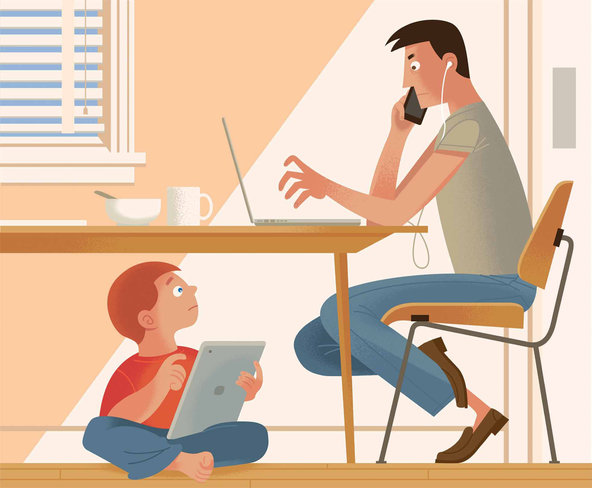How to Cut Children’s Screen Time? Say No to Yourself First

Parents are often at fault, directly or indirectly, when children and teenagers become hooked on electronic media, playing video games or sending texts many hours a day instead of interacting with the real world and the people in it. And as discussed in last week’s column, digital overload can impair a child’s social, emotional and intellectual growth.
This sad conclusion of many experts in child development has prompted them to suggest ways parents can prevent or rectify the problem before undue damage occurs.
“There’s nothing about this that can’t be fixed,” said Catherine Steiner-Adair, a Harvard-affiliated psychologist. “And the sooner, the better.”
As Susan Stiffelman, a family therapist, put it in The Huffington Post, today’s parents are unprepared “to deal with the intense pull and highly addictive nature of what the online world has to offer. As parents, we have an opportunity to guide our kids so that they can learn habits that help them make use of the digital world, without being swallowed whole by it.”
Two experts at the Harvard School of Public Health, Steven Gortmaker and Kaley Skapinsky, offer a free guide, “Outsmarting the Smart Screens: A Parent’s Guide to the Tools That Are Here to Help,” as well as healthy activities to pursue to counter the weight gain that can accompany excessive screen time. Young children should not have their own cellphones or televisions in their bedrooms, they say, adding that even with teenagers it is not too late to set reasonable limits on screen time.
Dr. Steiner-Adair, author of “The Big Disconnect: Protecting Childhood and Family Relationships in the Digital Age,” cited two common parental behaviors that can strongly influence a child’s tendency to abuse electronic media. Some parents are perpetually tuned into their own devices, responding to every ping of their cellphones and tablets, receiving and sending messages at times that would enrage Miss Manners. Other parents fail to establish and enforce appropriate rules for media engagement by their children.
Young children learn by example, often copying the behavior of adults. I often see youngsters in strollers or on foot with a parent or caretaker who is chatting or texting on a cellphone instead of conversing with the children in their charge. Dr. Steiner-Adair said parents should think twice before using a mobile device when with their children. She suggests parents check email before the children get up, while they are in school, or after they go to bed.
One girl among the 1,000 children she interviewed in preparing her book said, “I feel like I’m just boring. I’m boring my dad because he will take any text, any call, any time, even on the ski lift.” A 4-year-old called her father’s smartphone a “stupid phone.”
Dr. Jenny S. Radesky, a pediatrician at Boston Medical Center who with two colleagues observed 55 groups of parents and children at fast-food restaurants, noted that 40 of the adults immediately took out mobile devices and used them throughout most of the meal. Often more attention was paid to the devices than to the children.
The researchers also found that when parents were absorbed in their own devices, the children were more likely to act out, apparently in an attempt to get their parents’ attention.
Dr. Steiner-Adair is especially concerned about parental failure to pay full attention to their children “at critical times of the day, like when taking children to and from school. This should be a cell-free zone for everyone — no Bluetooth for parents or devices for the kids. The pickup from school is a very important transitional time for kids, a time for them to download their day. Parents shouldn’t be saying, ‘Wait a minute, I have to finish this call.’ ”
Likewise, she said, when parents come home from work, “they should walk in the door unplugged and use the first hour they’re home as time to reconnect with the family. Kids hate the phrase ‘just checking’ that parents frequently use to justify a very rude, infuriating behavior.”
Nor should parents or children be using devices when the family dines out, the psychologist said. “The art of dining and the connection between delicious food and nourishing conversation is being lost, not just in restaurants but at home as well,” she said.
Dr. Steiner-Adair attributes a recent 20 percent increase in accidental injuries seen in pediatric emergency rooms to caretakers’ failure to pay full attention to those they are supposed to be watching, like infants and toddlers in the bathtub or children on the jungle gym. “Your reaction time and attention is not the same when you’re texting or talking on a cellphone,” she said.
Ms. Stiffelman, author of “Parenting With Presence,” realizes that attempts to change digital behavior can meet with resistance. But, she said, it is important to be fearless and decisive, and to avoid negotiations.
“Acknowledge your kid’s upset without delivering long lectures about why they can’t have what they want,” she said. “Children grow into resilient adults by living through disappointment. It’s O.K. for your kids to be mad, bored or anxious about missing out on what their friends are up to online.”
She and other experts urge parents to establish device-free times of day, like the first hour after school and the hour before bed. Cellphones and tablets should not be allowed at the dinner table.
Ms. Stiffelman suggests parents “make time for real-life activities with your kids that let them know that they’re worth your time and undivided attention. Do things together that nourish your relationship.”
As for controlling the time children spend on digital media, the Harvard guide states emphatically that it is the parents’ responsibility: “Since the devices can be turned on anytime, you as a parent need to monitor their use, keep track of time, and then make sure the agreed upon rules are followed.”
